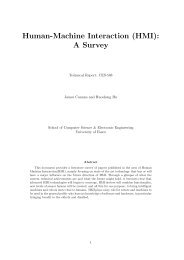General Schema Theory for Genetic Programming with Subtree ...
General Schema Theory for Genetic Programming with Subtree ...
General Schema Theory for Genetic Programming with Subtree ...
Create successful ePaper yourself
Turn your PDF publications into a flip-book with our unique Google optimized e-Paper software.
<strong>General</strong> <strong>Schema</strong> <strong>Theory</strong> <strong>for</strong> GP: Part II<br />
schema theorem (Whigham, 1995; Whigham, 1996). In CFG-GP programs are generated<br />
by applying a set of rewrite rules taken from a pre-defined grammar to a start<br />
symbol S. In CFG-GP the individuals in the population are derivation trees whose internal<br />
nodes are rewrite rules and whose terminals are the functions and terminals used<br />
in the program. Whigham defines a schema as a partial derivation tree rooted in some<br />
non-terminal node, i.e. as a collection of rewrite rules organised into a single derivation<br />
tree. So, a schema represents all the programs that can be obtained by completing the<br />
schema and all the programs represented by schemata which contain it as a component.<br />
When the root node of a schema is not S, the schema can occur multiple times in the<br />
derivation tree of the same program because of the absence of positional in<strong>for</strong>mation in<br />
the schema definition. Whigham’s definition of schema led him to derive an interesting<br />
worst-case-scenario schema theorem which provides a lower bound <strong>for</strong> the number of<br />
instances of a schema at the next generation as a function of some macroscopic quantities<br />
such as the probabilities of disruption of schemata under crossover and mutation,<br />
and the fitness of the schema. Like in Altenberg and O’Reilly’s cases, this theorem describes<br />
the way in which the components of the representation of a schema propagate<br />
from one generation to the next, rather than the way the number of programs sampling<br />
a given schema changes over time.<br />
2.1.2 Theories on Positioned <strong>Schema</strong> Propagation<br />
In 1997 two schema theories (developed at the same time and independently) were<br />
proposed (Rosca, 1997; Poli and Langdon, 1997b) in which schemata are represented<br />
using rooted trees or tree fragments. The rootedness of these schema representations<br />
is very important as they introduce in the schema definition the positional in<strong>for</strong>mation<br />
lacking in previous definitions of schema <strong>for</strong> GP. As a consequence a schema can be<br />
instantiated at most once <strong>with</strong>in a program and studying the propagation of the components<br />
of the schema in the population is equivalent to analysing the way the number<br />
of programs sampling the schema changes over time.<br />
Rosca (Rosca, 1997) proposed a definition of schema, called rooted tree-schema, in<br />
which a schema is a rooted contiguous tree fragment. For example, the rooted treeschema<br />
£ =(+ # x) represents all the programs whose root node is a + <strong>with</strong> x as<br />
its second argument. Rosca derived a microscopic schema theorem <strong>for</strong> GP <strong>with</strong> standard<br />
crossover (when crossover points are selected uni<strong>for</strong>mly) which provided a lower<br />
bound <strong>for</strong> the expected number of individuals belonging to a schema in the next generation<br />
as a function of quantities such as the size of the programs matching the schema,<br />
their fitness and the order of a schema.<br />
In (Poli and Langdon, 1997b) we proposed a simple definition of rooted schema<br />
<strong>for</strong> GP which allowed us to derive a worst-case-scenario schema theorem <strong>for</strong> GP; this<br />
definition has subsequently been used to derive a variety of exact results, including<br />
those reported in this paper. The definition is as follows:<br />
Definition 1 (GP <strong>Schema</strong>) A GP schema is a tree composed of functions from the ����¡�� set<br />
and terminals from the set ����¡���¢ , where � and � are the function and terminal sets used<br />
¢<br />
in a GP run. 6 The � primitive is a “don’t care” symbol which stands <strong>for</strong> a single terminal or<br />
function. The � ¥ £�� order of a GP £ schema is the number non-� of symbols it contains.<br />
A schema £ represents programs having the same shape as £ and the same la-<br />
6 In this paper we use the convention that the root node of a program or a schema also has an output link.<br />
As a result there is always a one-to-one correspondence between nodes and links, and, there<strong>for</strong>e, we can<br />
consider crossover points either as nodes or as links. We will also assume that the root node (or its output<br />
link) can be chosen <strong>for</strong> crossover.<br />
Evolutionary Computation Volume ?, Number ? 7




